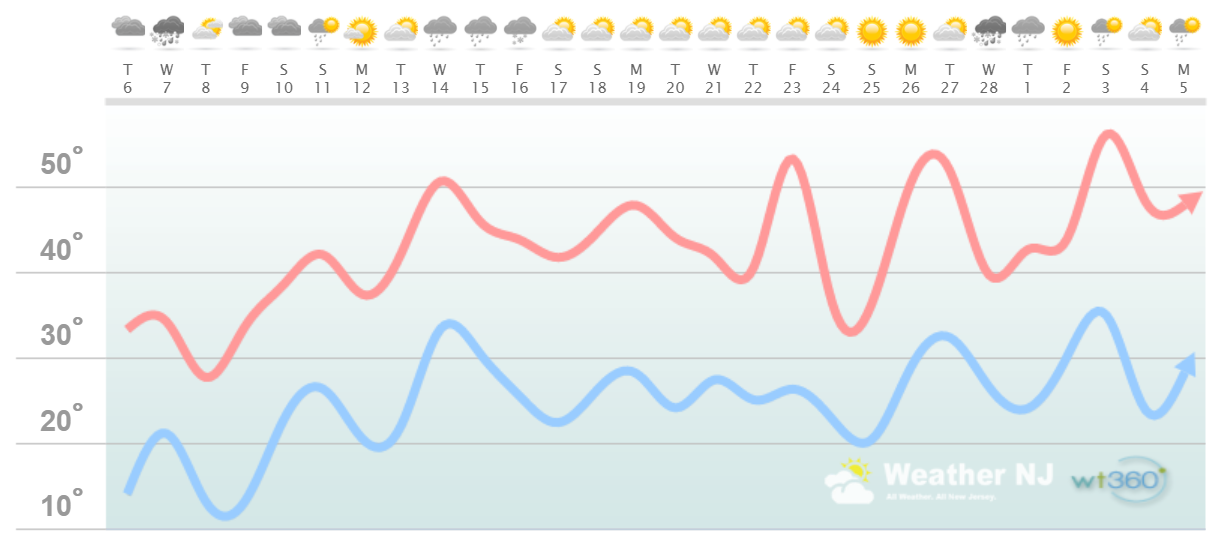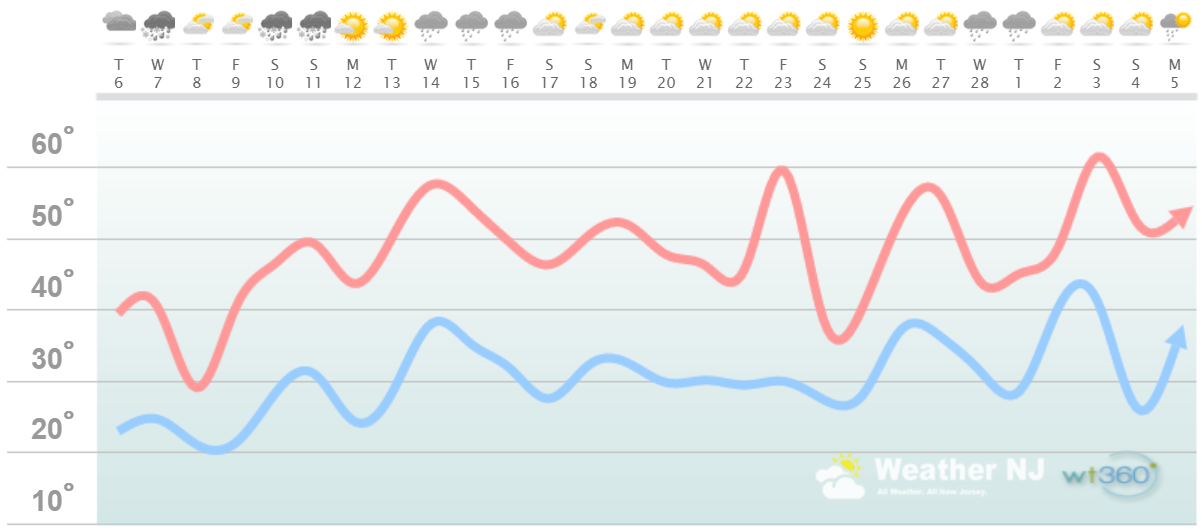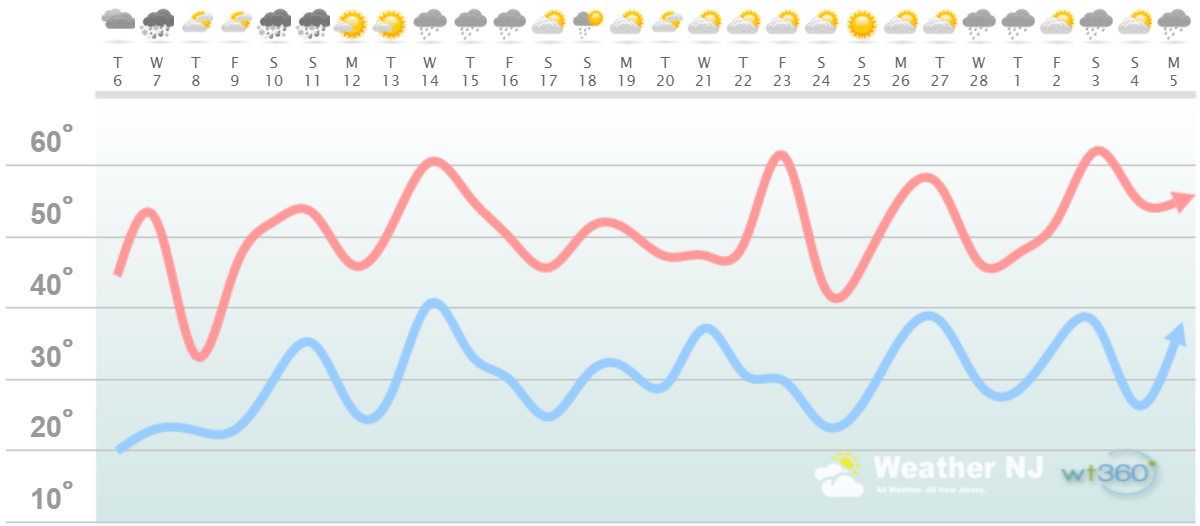February Discussion with WeatherTrends360

It’s time to harness the WeatherTrends360 proprietary weather algorithms to see how the rest of February 2018 should play out. But first lets break New Jersey into proper climatological regions. We have the higher elevations of NNJ/NWNJ, the interior coastal plain (SWNJ through CNJ and into NENJ – Newark Basin), and the coastal regions (most of SENJ coast – Sandy Hook down and around Cape May into Delaware Bay). I’ll be representing each climatological region with a 28-day graph from weathertrends360 data followed by a brief discussion.
Please keep in mind that these algorithms are documented with an 84% verification rate and are based on oceanic water cycles, time table series and very complex mathematics. The best takeaway from this data are general trends (cool vs warm, rainy vs dry, etc). I’m always hesitant to forecast specific surface conditions (rainfall amounts, snowfall amounts, winds, etc) beyond the 4-7 day forecasting period. But temperature and precipitation trends is what WeatherTrends360 does best with their proprietary mathematical analysis derived from over 150 years of reactive pattern data. For this reason, let’s call this a long-range discussion of expectations rather than a locked-in forecast.
Higher Elevations of NNJ/NWNJ
(Sussex, Warren, Hunterdon, Morris, N. Somerset, and N. Passaic) – Known for little to no Atlantic Ocean influence, colder-snowier winters, and drier conditions in general when compared to the coast. This rnown to get hot when high pressure sits overhead during the summer and bitterly cold during Arctic outbreaks in the winter. Elevation is a major influence that separates this micro-climate from the rest of New Jersey. This region extends into NE PA (Poconos) and parts of NY State (Catskills).
Higher Elevation Discussion: When looking at the temperature trend, the average February 2018 temperature is expected to rise. This is normal for February since we’re just past the coldest part of the year. Notice all the peaks and dips though? It’s anything but a smooth ride! This is very typical of La Nina and it’s exactly what I expect to happen. Therefore we should see alternating transient periods of cold/dry and mild/more humid/even wet as we head through February into early March. This region should be the coldest of New Jersey for this period. Days of failing to escape the 30s for highs are becoming limited. Overnight lows however should still have no problem dropping into the 20s and teens, especially the highest elevations of NWNJ. More precipitation is expected for the first-half of February 2018 than the second half. You can’t hang up the snowy season in this region until well-into March. Even April snow showers are common for NWNJ elevations. No major winter storm signals currently exist in the 7-day forecast period however.
Interior Coastal Plain and Newark Basin from SWNJ-CNJ-NENJ
(Salem, Gloucester, Camden, W. Burlington, Mercer, W. Monmouth, Middlesex, S. Somerset, Union, Essex, Hudson, Bergen, and S. Passaic) – Known for naturally higher temperatures due to lower elevations away from the oceanic influence. This region is also known as “heat island” due to transportation (I-95 corridor), smog, abundant asphalt, concrete, and other man-made substances that naturally absorb and retain heat moreso than natural protected land. This is why excessive heat warnings and air quality alerts are more common in this region. SWNJ always tends to run a few degrees warmer than NENJ but this region is very similar otherwise in micro-climate due to the parallel nature of the Appalachian Mountain elevations to the NW. The same micro-climate can be extended into SE PA and NE MD which tends to run just a little stormier than NJ. This however is what makes up the interior coastal plain.
Interior Coastal Plain and Newark Basin Discussion: When looking at the temperature trend, the average February 2018 temperature is expected to rise. This is normal for February since we’re just past the coldest part of the year. Notice all the peaks and dips though? It’s anything but a smooth ride! This is very typical of La Nina and it’s exactly what I expect to happen. Therefore we should see alternating transient periods of cold/dry and mild/more humid/even wet as we head through February into early March. Days of failing to escape the 30s for highs are becoming very limited for this region. Overnight lows however should still have no problem dropping into the 20s. We’re getting to the point where significant snow accumulations need to happen overnight. We should be there by President’s Day Weekend. More precipitation is expected for the first-half of February 2018 than the second half. You can’t hang up the snowy season in this region until well-into March. No major winter storm signals currently exist in the 7-day forecast period however.
Coastal Regions of SENJ
(Cumberland, Cape May, Atlantic, E. Burlington, Ocean, and E. Monmouth) – Known for tremendous influence from the Atlantic Ocean. Oceanic influence keeps this zone cooler in the summer and warmer in the winter than the interior coastal plain and especially the higher elevations of NWNJ. In the summer, sea breeze fronts back into the coast and can ignite thunderstorms if enough instability is present. The cooler marine air slides under the hot air to the W and provides additional atmospheric lifting. This is both why it’s 5-15 degrees cooler at the shore than the Philly-Trenton area and why near-stationary thunderstorms can form along the coast capable of producing localized flash flooding. In the winter, the ocean is warmer than interior regions which plays a huge role in rain vs. snow—highly dependent on wind direction. When the winds chance from NE to N/NE, that’s usually when temps crash and change rain over to snow. Regardless, this micro-climate is well known, well documented and well expressed. This region extends into most of Delaware as well.
Coastal Region Discussion: When looking at the temperature trend, the average February 2018 temperature is expected to gradually rise. This is normal for February since we’re just past the coldest part of the year. Notice all the peaks and dips though? It’s anything but a smooth ride! This is very typical of La Nina and it’s exactly what I expect to happen. Therefore we should see alternating transient periods of cold/dry and mild/more humid/even wet as we head through February into early March. This region should be the mildest of New Jersey for this period. After this week, we’re probably finished with days that fail to escape the 30s for highs. Overnight lows however should still have no problem dropping into the 20s and 30s. We’re getting to the point where significant snow accumulations need to happen overnight. We should be there by President’s Day Weekend. More precipitation is expected for the first-half of February 2018 than the second half. You can’t hang up the snowy season in this region until mid-March. Ocean temperatures are at their annual coldest. A properly-positioned coastal low would do it (see President’s Day Weekend 2003, March 1993 and the many late-spring snow events that occurred in 2014 and last year. No major winter storm signals currently exist in the 7-day forecast period however I’ll be watching for the classic coastal signal should such enter the 7-day forecasting period.
In English: All of New Jersey is expected to gradually increase in average temperature between now and the start of March. This is normal climatology having just moved out of January and heading towards spring (over the hill of winter). La Nina still has a hold on the pattern which is most recognizable by the volatile swings between cold/dry and mild/wet. While no major snow storms are on the near-future table, we cannot let our guard down until well-into March. I cannot guarantee a snow storm before winter’s end nor can I promise you we are finished with snow for the winter. What I can do is remind everyone about 1993, 2003, 2014 and last year (for NNJ) and how we still have a bit to go. I appreciate the cheering from snow-haters who assume winter is over. I also appreciate the disappointment from snow-lovers who assume winter is over. The passion of the full spectrum of NJ weather emotion has always been strong in this fan-base but as you all know, I have to call it like it is. Have a great month and please be safe! JC
Weathertrends360 is a complete, global, web solution to help retailers and suppliers capitalize on the weather and its influence on sales and marketing plans up to a year ahead. Learn how to become PROACTIVE vs REACTIVE with the weather in every phase of your business – how much inventory to buy/produce, where to allocate more/less, when to run weather-optimized advertising/marketing campaigns – weathertrends360 can help you determine all of this in minutes! 84% independently audited accuracy for both short-term and year-ahead forecasts for temperature and precipitation.
Jonathan Carr (JC) is the founder and sole operator of Weather NJ, New Jersey’s largest independent weather reporting agency. Since 2010, Jonathan has provided weather safety discussion and forecasting services for New Jersey and surrounding areas through the web and social media. Originally branded as Severe NJ Weather (before 2014), Weather NJ is proud to bring you accurate and responsible forecast discussion ahead of high-stakes weather scenarios that impact this great garden state of ours. All Weather. All New Jersey.™ Be safe! JC












